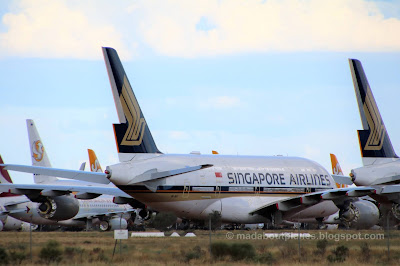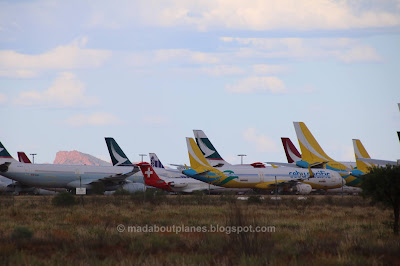Last August I flew out to Alice Springs to view the aircraft at the Asia Pacific Aircraft Storage facility (APAS) and back then there were around 65 aircraft.
 |
| TAKEN BACK ON THE 15th AUGUST 2020 |
Last Friday I once again flew out to Alice Springs especially to view the aircraft parked there. This time there were 140 aircraft and it really is a sight that needs to be seen.
 |
| TAKEN ON THE 19th FEBRUARY 2021 |
Like last time, I hired a helicopter from Alice Springs Helicopters Alice Springs Helicopters – Sightseeing Flights ALice Springs for a twenty minute hover around the air park. Kat, the pilot, is amazing seriously and will go and do what ever you want. Higher, lower, closer, further out, no issues. I strongly recommend hiring a helicopter as seeing these aircraft from the ground doesn't do it justice, as you can see by the below photos.
The world's newest "airliner boneyard" was completed in 2013; it began operations in June of 2014.
The storage facility is operated by Asia Pacific Aircraft Storage (APAS) Ltd. which chose Alice Springs because its dry, arid climate is ideal for aircraft storage and preservation. It caters to Asia-Pacific carriers as well as other airlines from around the world. It is capable of handling all aircraft types, including the Airbus A380, Boeing 747 and Boeing 777. APAS represents the first commercial aircraft storage and recycling facility in the Asia Pacific region. The facility was ultimately selected due to its climatic suitability, significant existing infrastructure and capacity for major expansion. Alice Springs offers the perfect environment for the preservation of aircraft and their inherent capital value. The facility benefits from an arid desert environment characterized by an average year round humidity of approximately 25%, outside Australia’s cyclone zone, low rainfall, and with low lying vegetation providing additional dust suppression qualities.
It takes a team of a dozen people up to five days to induct a plane for storage. Two of those are spent entirely on taping and covering everything to protect the engines and systems, a process that can take between 40 and 50 rolls of tape. Every plane has different requirements, depending on the manual. Airbus, for example, requires all passenger windows be covered and taped as well, while Boeing does not. Once inducted, sealed and towed to a parking bay, each plane is on a rolling system of 7, 30 and 90-day checks. During this time, bags of desiccant* in the engine bays are examined, tyres are rotated, and brake systems are maintained. Storing a plane is certainly not simply a matter of parking it and walking away. When will these aircraft return to their owners remains an open question. For now, these planes sit silently in the Australian outback, a surreal monument to a different time.
Alice Springs Airport (IATA: ASP, ICAO: YBAS) is a regional airport 13 km (8.1 miles) south of Alice Springs in the Northern Territory of Australia. The airport has two runways, the principal one (12/30) at 2,438m in length and 45m in width, the second (and rarely used) is 17/35 and is 1,133m in length. The only scheduled flights using the airport are domestic, although international charters do use the airport at times. The airport is open 24/7 and there are no restricted flight paths for noise abatement procedures.































No comments:
Post a Comment